Getting The Knack
Even with the hindsight and clarity of over three decades, it is difficult to describe the impact the Knack had on radio, fashion and rock and roll. The story of the Knack was all too familiar. An overnight success that was several years in the making. Songs that would ultimately find their way onto their multi-platinum debut had been turned down by a host of record labels in the early and mid seventies. But the Knack found their time.
During the late seventies, disco had a virtual hammerlock on the charts and radio airplay. Spearheaded by such artists as the Bee Gees (who delivered six chart toppers in less than eighteen months), Donna Summer (the queen of disco) and the Saturday Night Fever soundtrack (which sold 25 million copies world-wide), disco’s dominance was so absolute that twenty-five of the first thirty-three weeks of 1979 saw a disco dance number perched atop the Billboard charts. It seemed as if rock and roll was dead. Radio formats had changed to accommodate disco music. Billboard even added a disco chart in deference to massive record sales. But all that would change. The world was about to get The Knack.
The Knack initially formed in May 1978. Fieger had arrived in L.A. in 1971 with the band Sky and began writing with Averre a few years later. Founding members Doug Fieger, Berton Averre, Bruce Gary and Prescott Niles sculptured a sound which was irresistibly familiar but at the same time unlike anything else which was playing on the radio. Its first performance, June 1, 1978, at the Whisky-A-Go-Go, was a sensation. Their tightly woven musical craftsmanship earned them many rave reviews in the local press. The record buying public and the music industry have always longed for the next big thing. That summer, it seemed, they had found it.
A huge draw in the LA club scene, the Knack played incessantly throughout California 1978 and early 1979. They revitalized live music in many of the older establishments which had been converted to disco dance halls, such as the Troubadour and Starwood with sellout crowds. Rolling Stone magazine followed the still unsigned band through several high profile performance jams with the likes of Bruce Springsteen, Tom Petty, The Doors’ Ray Manzerak, Stephen Stills, and Eddie Money. Energetic sets featuring hard driving original music scattered with chestnuts from Buddy Holly, The Kinks and The Doors won them a loyal and enthusiastic following.
By November of 1978, thirteen record companies engaged in a fierce bidding war for the band’s services which was eventually won by Capital Records. The selection of a record producer was the source of much speculation. Even “Wall of Sound” architect Phil Spector was anxious to participate. However, the job went to someone the band hadn’t even considered, Mike Chapman. A songwriter and member of the hitmaking band Sweet, Mike Chapman had enjoyed a successful career behind the board as a producer, racking up an impressive run of number one records for Exile, Nick Gilder, and Blondie. Chapman read an article the LA Times which identified the producers the band most wanted to work with. His name wasn’t on the list. Sensing a blockbuster, Chapman convinced the band to allow him to produce and signed on.
With a team now firmly in place, The Knack and Chapman entered the studio, eager to capture the energy of their live performances. While artists such as The Eagles and Fleetwood Mac were spending more than a year and a million dollars to produce an album, Get The Knack was recorded in just eleven days for a miserly $17,000. The Knack performed the songs “live” with minimal overdubs. Chapman, basically hit the record button and let the band play. Originally, a double album was considered, but the final track listing focused on the mainstays of their stage show.
Capitol Records introduced the record with the kind of fanfare not seen since the first wave of the British Invasion. With marketing support from Capitol and a cadre of infectious pop tunes, the record flew off the shelves. Rolling Stone magazine heralded them as “the new fab four”, an obvious reference to The Beatles. Gold certification took 13 days. Platinum certification came in less than seven weeks, making Get The Knack one of the fastest to gold / platinum debut albums of all time. “My Sharona” entered the Hot 100 on June 23, 1979 and reached number one nine weeks later on August 25, 1979 where it remained for six weeks. During the summer of 1979, culminating with a riotous sold out performance in New York’s legendary Carnegie Hall, the Knack was unavoidable. It seemed as if every stereo and car radio reverberated with the thunderous hook of their number one smash. It took rock icons Led Zepplin to finally relieve them of the number one album position in the fall of ‘79. Billboard named “Sharona” as the number one single of 1979. Today, it still ranks as one of the biggest selling singles of the rock era.
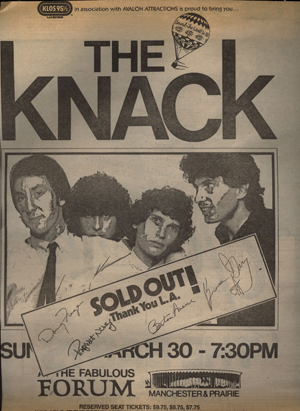 A sold out world tour followed the album’s release, but the lines of demarcation were already being drawn. Where the Knack was concerned, either you “got it” or you didn’t. Critics of the band fixated on the stark, black and white photo of the album’s cover and performance photo on the back as obvious send ups of The Beatles first album Meet The Beatles. Dissenters labeled the songs as derivative even though the albums sound nothing like the Beatles. Some critics opined that musicians who were this smart and this good couldn’t possibly be serious about pop music and therefore were insincere and manipulative. Yet the album continued to sell, finally moving in excess of six million copies. The band’s second single “Good Girl’s Don’t” sold respectfully, reaching number 11 on the Billboard charts. In spite of a growing backlash from critics for their “instant” fame, the public still demanded more product from The Knack. However, instead of harvesting another single from Get The Knack the band returned to the studio to record a follow-up pausing briefly for a rousing homecoming performance at a capacity filled L.A. Forum.
A sold out world tour followed the album’s release, but the lines of demarcation were already being drawn. Where the Knack was concerned, either you “got it” or you didn’t. Critics of the band fixated on the stark, black and white photo of the album’s cover and performance photo on the back as obvious send ups of The Beatles first album Meet The Beatles. Dissenters labeled the songs as derivative even though the albums sound nothing like the Beatles. Some critics opined that musicians who were this smart and this good couldn’t possibly be serious about pop music and therefore were insincere and manipulative. Yet the album continued to sell, finally moving in excess of six million copies. The band’s second single “Good Girl’s Don’t” sold respectfully, reaching number 11 on the Billboard charts. In spite of a growing backlash from critics for their “instant” fame, the public still demanded more product from The Knack. However, instead of harvesting another single from Get The Knack the band returned to the studio to record a follow-up pausing briefly for a rousing homecoming performance at a capacity filled L.A. Forum.
The band’s second effort, …but the little girls understand, (released less than eight months after their debut) was recorded in two weeks, immediately went gold, sold two and a half million copies worldwide, and sported a top 40 single “Baby Talks Dirty”. Even as a “Knuke The Knack” campaign sprung up by an enterprising profiteer from San Francisco, industry peers nominated the boys for two Grammy awards. The band carried on, released another single “Can’t Put A Price On Love” and continued to tour into the spring of 1980, before taking a much needed break.
A year passed before the band returned to the studio in late 1981 for their third album. Round Trip was directed by veteran producer Jack Douglass, fresh from his work on John Lennon’s Double Fantasy. This record was a much more polished effort than The Knack’s first two outings and clearly showcased a wide variety of songwriting styles without straying from The Knack “sound”. The initial single “Pay the Devil” was supported by a media blitz and a club tour designed to take the band back to their roots. The Knack disposed of their no interview policy which had been adopted for the first album and were profiled in a CNN interview and appeared on a variety of magazine covers. But it was too late. As quickly as they burst into the public conscience they were gone. Three week’s into the tour, on New Year’s Day, the band broke up. The constant drubbing from some quarters of the musical press and self styled opinion makers had taken their toll on the band. The energy which had introduced the band to the world had been depleted as the band had to defend their success to a press corp wary of their “instant” fame. Fieger, Averre, Gary and Niles went their separate ways. Fieger went on to act (Rosanne), produce and contributed songs for the Manhattan Transfer’s Grammy award winning effort Brasil. Averre played with Bette Midler. Gary drummed behind Bob Dylan, Jack Bruce and Bette Midler as well as producing with Alan Douglas a series of albums from guitar legend Jimi Hendrix. Niles worked with Josie Cotton (“Johnny Are You Queer’) and continued with session and performance work.
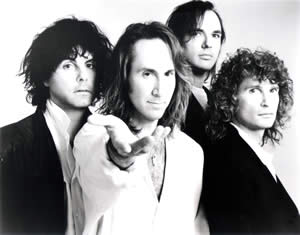 The band regrouped in 1986 / 87 for a tour but failed to release an album despite enthusiastic reactions from fans to their new material. In 1991, a revised lineup (Billy Ward replaced Bruce Gary on drums) released the Don Was produced album “Serious Fun”. The first single “Rocket Of Love” was Top 10 AOR and the band received significant media attention but the label unexpectantly shelved the record and promotion for the album disappeared even as a second single “One Day At A Time” was being pressed for release.
The band regrouped in 1986 / 87 for a tour but failed to release an album despite enthusiastic reactions from fans to their new material. In 1991, a revised lineup (Billy Ward replaced Bruce Gary on drums) released the Don Was produced album “Serious Fun”. The first single “Rocket Of Love” was Top 10 AOR and the band received significant media attention but the label unexpectantly shelved the record and promotion for the album disappeared even as a second single “One Day At A Time” was being pressed for release.
Getting The Knack Again
In 1994, “My Sharona’s” popularity was reaffirmed when the song re-entered the Hot 100 after appearing on the soundtrack for the hit movie “Reality Bites”. The band had been offered two films in one day and had to choose between them. “One was for this hip comedy starring Winona Ryder,” says Averre, “and the other was for the homosexual rape scene in Pulp Fiction. Hmmm, that’s a tough choice.” Suddenly, teenagers too young to remember the song the first time around fell in love with it and “My Sharona” became only the 10th former #1 hit to chart again. It also prompted a tour of 32 cities. Despite no new songs to offer, the response was phenomenal.
In 1997, the band surfaced on two tribute albums. Come And Get It: A Tribute To Badfinger, brought the original four members back into the studio to record “No Matter What”. This Badfinger classic had been a staple of The Knack’s live show for years and was a natural for inclusion. The bands fiery rendition was a highlight of the disc and garnered radio airplay in selected markets. Capital Records released a two disc record of Bruce Springsteen covers. The Knack gladly offered up their version of “Don’t Look Back” which had previously only been available on the band’s Retrospective.
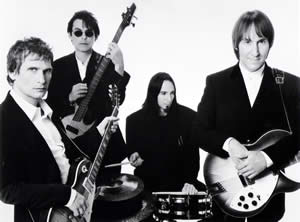 In April of 1997, the band performed to a capacity crowd at Hollywood’s Viper Room. Among the audience was Harold Bronson, President of Rhino Records. The set included expected Knack standards, along with a handful of new songs. The audience reponse to both the old and new material was overwhelmingly positive. Bronson, a long time fan of the band’s music, immediately brought the band to Rhino and commenced recording of a new CD. (“It’s not that he isn’t used to seeing Rhino acts live, it’s that he’s not used to seeing them alive at all,” quipped guitarist Berton Averre.) The result of this effort was the release of Zoom, in 1998. The fourteen classic compositions were produced by Richard Bosworth (Don Henley, Steve Perry) and featuring the drumming of Terry Bozzio (Frank Zappa, Missing Persons). Demonstrating their commitment to the band, Rhino also issued Proof: The Very Best Of The Knack. This CD contains remastered versions of Knack classics and four new tracks not available on any other release.
In April of 1997, the band performed to a capacity crowd at Hollywood’s Viper Room. Among the audience was Harold Bronson, President of Rhino Records. The set included expected Knack standards, along with a handful of new songs. The audience reponse to both the old and new material was overwhelmingly positive. Bronson, a long time fan of the band’s music, immediately brought the band to Rhino and commenced recording of a new CD. (“It’s not that he isn’t used to seeing Rhino acts live, it’s that he’s not used to seeing them alive at all,” quipped guitarist Berton Averre.) The result of this effort was the release of Zoom, in 1998. The fourteen classic compositions were produced by Richard Bosworth (Don Henley, Steve Perry) and featuring the drumming of Terry Bozzio (Frank Zappa, Missing Persons). Demonstrating their commitment to the band, Rhino also issued Proof: The Very Best Of The Knack. This CD contains remastered versions of Knack classics and four new tracks not available on any other release.
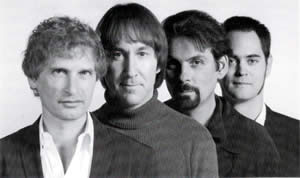 Throughout the first decade of the new millennium The Knack continued to tour, backed by drummers David “Holmes Jones” Henderson and Pat Torpey. In 2001, in a distribution deal with Image Entertainment, they released of their fifth studio album Normal as the Next Guy. This was followed in 2002 by The Knack – Live From the Rock ‘n’ Roll Funhouse, an in-studio concert CD that was also videotaped and released on DVD. And later that year, Zoom was reissued with two additional tracks under the repackaged title, ReZoom.
Throughout the first decade of the new millennium The Knack continued to tour, backed by drummers David “Holmes Jones” Henderson and Pat Torpey. In 2001, in a distribution deal with Image Entertainment, they released of their fifth studio album Normal as the Next Guy. This was followed in 2002 by The Knack – Live From the Rock ‘n’ Roll Funhouse, an in-studio concert CD that was also videotaped and released on DVD. And later that year, Zoom was reissued with two additional tracks under the repackaged title, ReZoom.
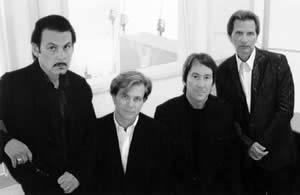 Bruce Gary died on August 22, 2006, after a long struggle with non-Hodgkin lymphoma.
Bruce Gary died on August 22, 2006, after a long struggle with non-Hodgkin lymphoma.
Unbelievably, during a concert in Las Vegas just prior to Bruce’s death, Doug began suffering from headaches and became disoriented on stage – even forgetting some of the lyrics to “My Sharona,” the song he had written and performed countless times. Back in L.A. doctors discovered two brain tumors, metastases from the lung cancer he had been treated for two years earlier. He battled the recurring tumors for over three years, even continuing to tour with the band, until finally succumbing on Valentine’s Day, 2010.
But music is immortal. The Knack will never be forgotten.
“We’ve already had the success you dream about. But we’ve never played our music for that. We play it because this is the only worthwhile pop music to make – fun and sad, silly and smart, explosive but sweet, snide but vulnerable. It’s not about being cool but about being goofy and having a great time. We didn’t invent this, but it’s what we do.” – Doug Fieger
“We didn’t stick a finger in the wind and say the time is right again. But with all the dark colors in music today, the ‘who gives a shit’ angst and post-modern depression, we strike a chord. Having fun and sometimes grabbing someone’s heart enough that they say, ‘Me too,’ is a noble pursuit.” – Berton Averre
“I’ll be the first to admit that we’re the ‘90s version of Cheap Trick or The Knack but the last to admit that it hasn’t been rewarding.” – Kurt Cobain, liner notes to Incesticide, (1992)
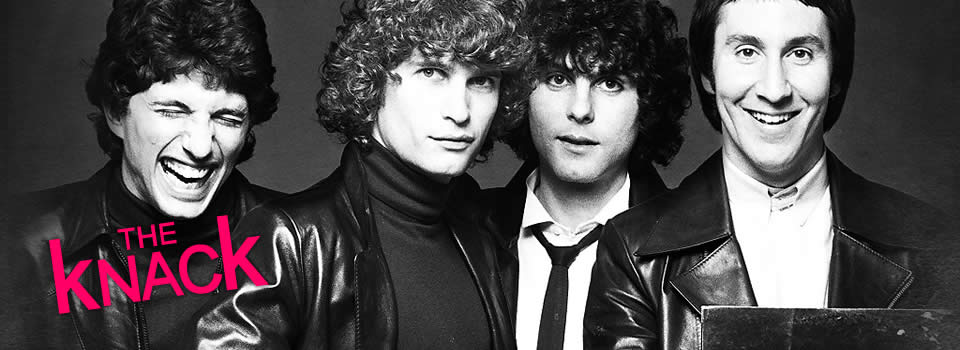




Connect With Us!